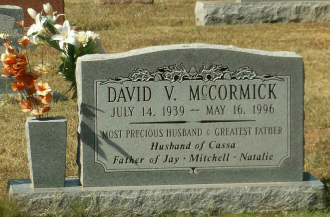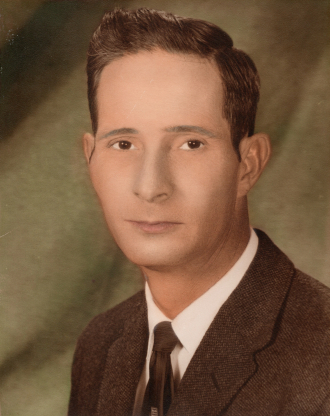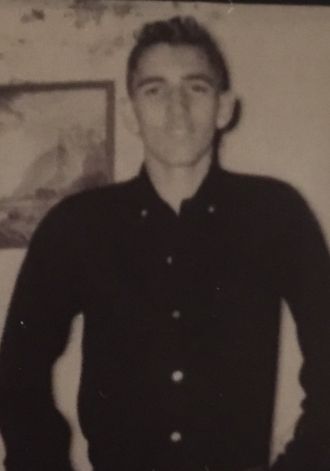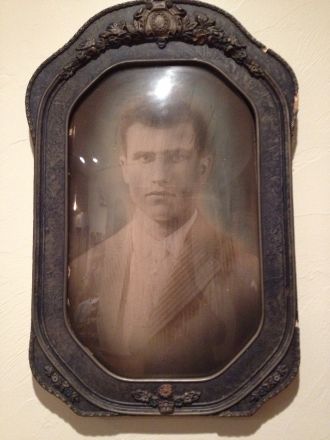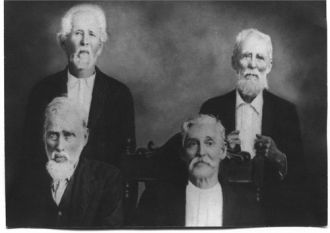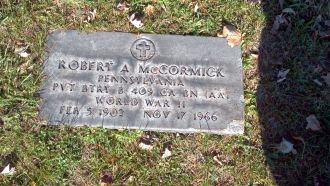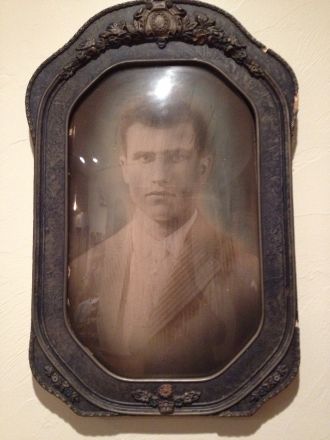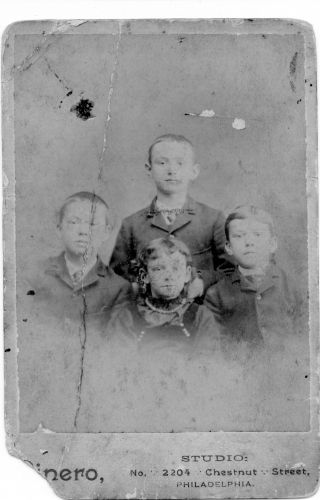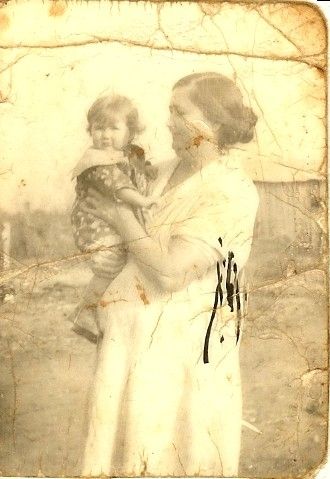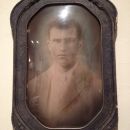McCormick Family History & Genealogy
McCormick Last Name History & Origin
AddHistory
We don't have any information on the history of the McCormick name. Have information to share?
Name Origin
We don't have any information on the origins of the McCormick name. Have information to share?
Spellings & Pronunciations
We don't have any alternate spellings or pronunciation information on the McCormick name. Have information to share?
Nationality & Ethnicity
We don't have any information on the nationality / ethnicity of the McCormick name. Have information to share?
Famous People named McCormick
Are there famous people from the McCormick family? Share their story.
Early McCormicks
These are the earliest records we have of the McCormick family.

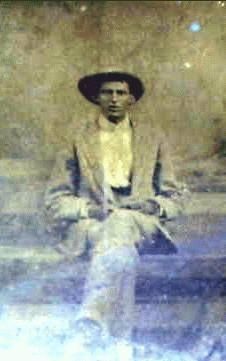
McCormick Family Members
McCormick Family Photos
Discover McCormick family photos shared by the community. These photos contain people and places related to the McCormick last name.

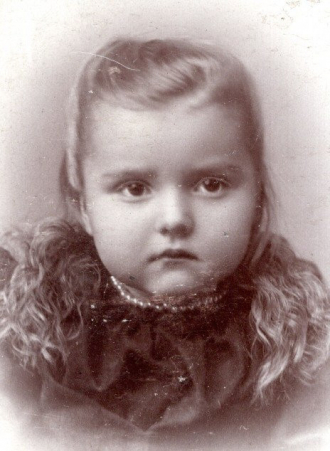
Edith Day MCCORMICK was b. 30 Sept 1889 in Oswegatchie, NY to parents John Danial or David MCCORMICK (1859-1924) and Elizabeth “Lizzie” Ella or Houston DAY (1861-1918). Edith married Clark Marney BOWMAN (1890-1954) on 9 Jul 1918 in St. Lawrence County, NY and they had four children including Elizabeth B. or D. BOWMAN MONTPELIER (1919-2016); Barbara BOWMAN LOWRY of LOWERY (1929-2020); and Robert McCormick BOWMAN (1923-1975); and John Clark BOWMAN (1926-1996).
Edith died 23 Mar 1989 in New York and is buried in the Ogdensburg Cemetery in that city.
I would like to get the photograph to a family member and would appreciate you contacting me if you are a member of this family or know someone who might be.
Thanks,
Shelley
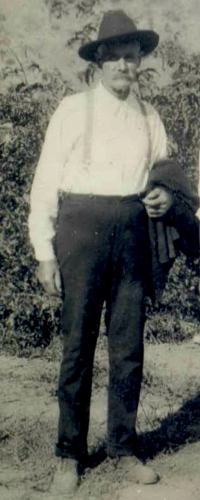
People in photo include: Frank McCormick
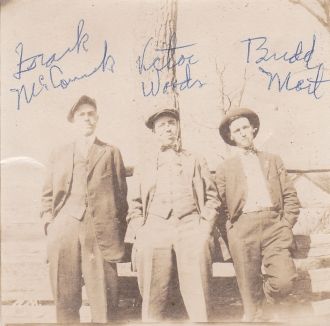
People in photo include: Frank McCormick and Victor Woods
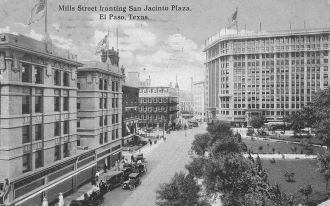


People in photo include: Helen v Nelson, Charles J Nelson, Charles F Nelson, Charlotte Nelson, Jennie Nelson, John Nelson, Frank Nelson, George T Nelson, Francis J Nelson, Thomas Cottle, Anthony Monaghan, Dorothy Nelson, Marie Nelson, Genevieve Nelson, Grace I Nelson, Irene Maher, Mae O'Kane, Irene Monahan Cottle, Florence McLoughlin, Mary C Monahan Ryan, Mary C Monahan Ryan, John Ryan, Harriet Drake, Ruth Rastner, Severn Myer, Edward Hicks, Sadie Henry, Mrs McCormick, Mrs Harold Farjeon, Mrs Severn Myer, Mrs Edward Hicks, Mrs Frank Nelson, Mrs William Drake, William Drake, Thomas Heath, and Nagle

People in photo include: S. Alice McCormick
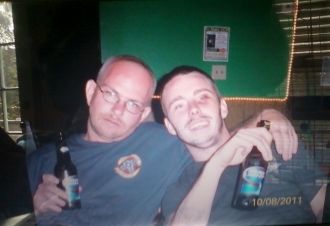
People in photo include: Jason Curtis Mccormick
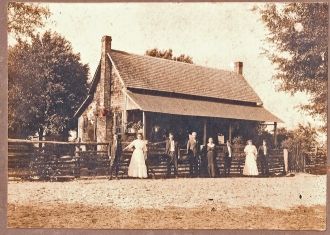
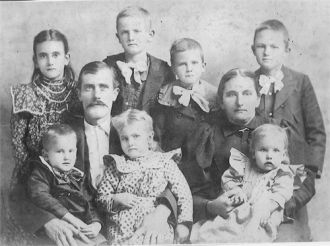

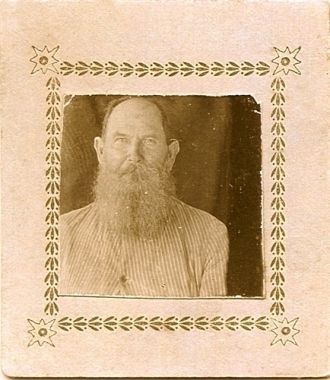
People in photo include: John Wayne McCormick
McCormick Family Tree
Discover the most common names, oldest records and life expectancy of people with the last name McCormick.
Updated McCormick Biographies
Popular McCormick Biographies


McCormick Death Records & Life Expectancy
The average age of a McCormick family member is 73.0 years old according to our database of 24,401 people with the last name McCormick that have a birth and death date listed.
Life Expectancy
Oldest McCormicks
These are the longest-lived members of the McCormick family on AncientFaces.
Other McCormick Records
Share memories about your McCormick family
Leave comments and ask questions related to the McCormick family.
 Linda Lehman
Linda Lehman Chapter VIII.
Reminiscences
(By Joshua Copland)
Page 64-70
I was born in Sumner county, Tennessee, Nov. 27th, 1812, settled three miles southwest of Vienna, Johnson county, 1816. Indians came to my father's house on the old Wilkinsonville, Cape Girardeau and Kaskaskia trail. Wilkinsonville was the remains of a fort with no soldiers or houses. Graveyard hill stood near, an open field of sixty acres, was about one-half mile from the fort, which stood near the head of the upper dyke. In 1833, I moved near Sharp's Landing.
Among the old settlers were John W. Read, Jacob Kidd, Robert McCormick, Ebenezer and Jessie Simpson, the Lairds, Hamilton Mitchell, Mr. Boyles, James Kincaid, Benajiah Thompson. Read lived at Belgrade.
Hillerman was a village in 1835 named L.D. Hillerman, a river man, who purchased it of William Parker, and the latter went to New Orleans. Hats were made there.
Capt. Burt Sexton came to this county, 1837 and settled at Indian Point. Metropolis did not exist. There was Wilcox's ferryman cabin. D. May's father lived five miles out. Hardy Taylor lived under the bluff. Americus Smith lived four miles beyond New Colombia.
In 1854 rain fell June 14th, and no more fell until late in the fall. This was the "dry year."
I delivered my corn at Copland's Ferry (Joppa) and got a $1.20 a bushel. Wheat was 75 cents to $1.40 a bushel. Joppa had a store kept by Dick Venable for Sam Copland of Vienna.
There were bear, wolf, elk, deer, panther, otter and beaver. Near Tucker's Mills in Lower Massac, was an elk glade where an elk was killed in 1855, and a bear was killed by David Sherer at Indian Point.
I remember John Renfro, a Methodist preacher; Stephen Renfro, a protestant Methodist; Hezekiah West and William Stanley, also Methodists; William Standard, Presbyterian, and Peter Cartwright, the great pioneer Methodist preacher, dedicated the Methodist church at New Columbia. Numbers had the jerks, dancing mania, etc., at revivals in 1847, '48 and '49. Revs. Thomas Lopez, Jacob and Valentine Lingumgelter, Methodists, conducted these meetings, Rev. George W. Hughey came later.
William Humphreys, one mile from Hillerman, was called out of his house and killed in 1863. He was in good circumstances. Tracks showed three assassins; object robbery. J.R. Jones, keeping store at Fletcher's Landing, was also called, but his wife kept him in. Nathan Evans, father of Attorney H.A. Evans, was hanged by three robbers the same night until he gave up $211. Nobody was arrested.
Joseph P. Bowker was an early teach in the "50's." "Old Bethlehem" Methodist church and school house was used, built in 1845. Here in 1857 was fought a celebrated fist-fight between men on different sides of a debate. The decision was unsatisfactory. They fought until exhausted. No one was killed. I remember the old Cave Creek school house-a five cornered log, with dirt floor, stick chimney and split-poplar benches for seats. The first teacher was Elder Champion Wilson of near New Colombia. James Elliott succeeded him. The first schools were subscription schools.
Robert McCormick
Mr. McCormick was born in Davison county, Ky., Nov. 11, 1812. He moved to Illinois Jan. 1st, 1819. His father William, and mother, whose maiden name was Keziah Bennett, accompanied by George McCormick, William's father, and John McCormick, William's brother, and Alexander Douglas and their families, emigrated from Davison county, Tenn., in that early day on a flat boat, down the Cumberland river.
There was a little town where Smithland, Ky., stands, Joseph Daniels lived in a little log cabin where Paducah now is, and a family of negroes lived in a log cabin on the present site of Brooklyn, Ill. They landed at the site of Brooklyn. His father's family were, father and mother and children, Robert, Edmund and sister Jemina. The father, William McCormick, died in 1822, and the mother later. (This was twenty-one years before the organization of Massac county.) Edmund died in January, 1835, and Jemina is dead.
We moved near Unionville, Massac county, to a farm known as the Hamlet Ferguson farm, owned by a man of that name who lived at Hamlettsburg and it took his name.
With my uncle I visited Fort Massac about the time we came here, 1819. An embankment and ditch enclosed about an acre and strong log cabins at intervals with gates between were built around the walls of the fort. I went into an empty underground room about sixteen feet square in the east end of the fort in 1822. No guns or implements of war were there and no trees inside the fort. My grandfather, George McCormick cleared the land below the fort, cultivated it many times and died there in 1850. There was a cleared space of about five acres around the fort, traversed with gravel walks. The fort buildings soon burned down. There were no full-blooded Indians in Massac county in 1819, although many could be seen at Paducah.
Some men lived here who did nothing but hunt, among them John Simkins, who died near Bay City in the "50's." John Bennett, my mother's brother, was also a hunter, but did other work. A saddle of venison, the half with the hind-quarters, sold for three bits" (37 1/2 c.) Simkins often gave one deer to have another carried out of the woods for him. Wild turkeys were so abundant hunters never wasted ammunition on them but caught hundreds in turkey pens.
Many men wore buckskins suits. Women wore such clothes as they made at home, with carding, spinning, weaving and dyeing. The settlers tanned their own leather, made their own pegs, lasts and shoes. Some things were bought at Smithland and a village was at Golconda. Mr. Loroth kept a mixed store and Dr. Sims lived there.
Paths led from Fort Massac back into the country. Scarcely a wagon and no carriages were in the country. Sleds and wooden trucks were used to haul. Trucks had wheels sawed off a log. All houses were log, with puncheon floors. Some lumber was sawed for floors, lofts and doors with a whip-saw, on a scaffold about eight feet high, on which a log was placed. One man stood on the ground, the other on the log and could cut a 100 feet a day.
Reuben King or David Rossen built the first saw mill with water power on Seven Mile creek, at the Henly place. They also ground our corn. We raised no wheat. Before this we had to depend on horse power to grind our grain. It took a horse mill two hours to grind a bushel of corn. It was a rude contrivance. For motive power one or two horses were hitched to a long lever attached to an upright shaft in which were seven or eight arms extending outward about ten feet. In these were holes bored for pins, and a band worked around these pins, which could be tightened by moving the pins. The band passed over a trundle-head, which turned an iron shaft or spindle on which was fixed the upper mill-stone. In this way our corn was ground. We also used a hand-mill, a tin grater and pounder. The pounder was made of a solid log four or five feet high, sawed off square at the top and a fire built on the top-burning a hole to contain a peck of grain. Then a sweep was erected over it similar to the old well sweep. On the end of this sweep was made a wooden maul, to be pulled down upon the corn in the rude hopper by hand, the sweep raising it up each time until the corn was sufficiently pounded.
The hand mill was made by fixing up a small stone upon a steady platform, four feet high. Upon this stone an upper stone was fitted and held in place by frame work. To this upper stone a handle was fixed, and the stone turned by hand. The mill was operated by the right and fed by the left hand. A frame work steadied the mill. The meal descended through a miniature spout, and was sifted through a seive made of dried, deer skin, perforated. Biscuit were unknown. Corn bread was rough. The first wheat I ever saw was in 1822 on my grandfather's-George McCormick's-farm, near where Unionville now stands. There were about three acres, cut with a reap hook, a curved knife with saw teeth. The grain was grasped in one hand and cut while held, the reaper being in half recumbent position, advancing in a zig-zag line.
Only a few settlers lived here. Wesley Stubbs and family lived near Unionville. John Stubbs killed a deer on Sunday and John Bennett and George McCormick remarked in Wesley Stubbs' presence that they saw the deer killed, where-upon Wesley, a justice of the peace, issued a warrant for his kinsman Stubbs for breaking the Sabbath laws. Bennett and McCormick appeared as witnesses, but were forced to confess that they were also hunting, which accounted for their being in the woods. Each was fined $3.00.
Benjamin Tittsworth and family lived neighbors to Stubbs. Ebenezer Simpson, the leading citizen of the day, lived where New Liberty stood. John H. Smith and Reuben Smith lived near the mouth of "Big Bay."
Ebenezer Simpson was a shoemaker and married a "Weaver." Daniel McCawley put up the first horse mill in the county in the Black Bottom. James Kincaid, a good man, was also a resident of the Black Bottom. Adijah ("Bige") Dyer, was the famous pioneer hunter and trapper. Solomon Lytton came soon after my father. His sons, Barnett and Solomon, are residents of Massac county. Reuben King was a pioneer blacksmith and lived on the same farm where he died about five miles northeast of Metropolis. John Dye's father, William, was King's neighbor, also Chester Hankins, and a family named Fox, a relative of Lytton's.
Wesley Stubbs, the justice, was a preacher, I think a Methodist. No churches were in the county, and when any one was called to preach a meeting was held at a house selected for the occasion. John Lamar was an old pioneer reared by a family named Sisk.
My sister, Jemina, married Elijah Smith in 1836, near where Brooklyn now is. I obtained the license in Golconda. They were the parents of Judge R.N. Smith.
We had no school houses. My first teacher was a Mr. Haskins, who taught near the site of New Liberty, 1825. Eli Fletcher, an Indian teacher, also taught in an early day. Numbers enlisted for the Black Hawk war, but saw no service.
I remember Belgrade had two or three families of bad reputation for counterfeiting. Henry Toulson bought them out. The Turners lived on what is now my farm and they were counterfeiters.
I was married to Elizabeth Hagar in 1836. Esquire Soloman Lytton, Sr., performed the ceremony at my home on the Brooklyn road. I had bought so many marriage licenses of John Raum, the clerk of Pope county, that I told him when I got my own he ought to make a reduction and sure enough he did. By saving my pennies I have managed to do fairly well. Soon after my marriage a free-negro minister, Methodist, came to the county. He was a better preacher that the Rev. Stubbs.
HON. T.B. HICKS' REMINISCENCES
My father moved to Metropolis, December, 1842, when there were probably a dozen houses, the most of them log. John H. Wilcox, who owned and operated the ferry; Joseph Becker, Maurice Van, John W. Carmichael, a man named Booth and a German named Benchi, lived there then. Benchi had three grown sons, James, Thomas, and Andrew, and two grown daughters, Rachel and Jane. Benchi kept a small general store. Mr. Wilcox also kept a store in the old brick hotel, built in 1839, and destroyed by the water and storm, 1884. A Mr. Hudson and Mr. Tony also lived here.
Metropolis was laid out as a city April 18, 1839. Paducah was then a small village. Two families lived at Belgrade, three miles above Metropolis on the Ohio river. The heads of both families were widows-Mesdames Rich and Gifford. The latter had two of the prettiest "gals" that ever fished in the Ohio river.
There was not a two horse wagon in the county. Ox teams did the hauling and the ox wagons could be heard to squeak two miles. Whatever was bought, no cash was considered in the transaction, but was to be paid in trade at trade rates. An ordinary cow could be bought for $5.00 in trade and the best cow for $8.00. The best horse brought $40, while pork sold at 1 1/2 cents a pound. No wheat was raised. Corn was worth from 10 to 12 cents a bushel. Coffee could be had at 10 cents and sugar was cheap. Eggs bought 3 cents a dozen and butter 10 cents a pound. Domestics sold for 25 cents a yard, calico, 15 to 20 cents. Every house had its loom and every housewife manufactured what the family wore. The largest piece of open farm land contained less than thirty acres. Only one frame house was in the county and stood where Elliott's furniture store now stands.
Dr. Padgett was the first physician I remember. Drs. A. M.L. McBane and John Hanna came soon after.
One of the first preachers of this county was D. Lopez, and he was one of the ablest pioneer preachers who ever occupied a pulpit. Thos. L. Garrett of Kentucky, an early Baptist minister, father of the Garrett brothers of Paducah, preached one sermon in particular, I distinctly remember. Services were conducted in a frame building where the calaboose now stands. His text was, "Fear not little flock, for it is your Father's good pleasure to give you the kingdom." The elder did full justice to the text. The first Methodist preacher I remember was a Rev. Covington.
On to Chapter IX
Return to History of Massac County by O.J. Page
Return to History of Massac County Homepage
Return to Massac County Homepage
Followers & Sources






